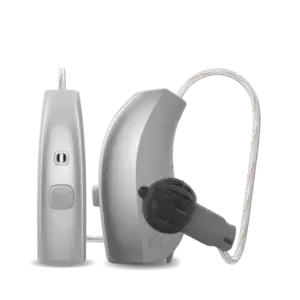Championing Patient-Centric Care: Bridging Transparent Pricing and Telehealth Support in Hearing Aid Solutions
In light of our new solution that blends transparent pricing with comprehensive telehealth support, we are poised to create a progressive model that prioritizes the patient while respecting the integrity of the hearing aid industry and hearing aid prices. This approach meets customer demands for affordability and accessibility without undermining the value of high-quality hearing health care.
To gain acceptance from both providers and manufacturers, we must demonstrate that this model not only addresses consumer needs but also benefits the entire industry. By focusing on patient-centered care, we can show how transparent pricing combined with expert telehealth consultations can enhance the overall user experience and ensure long-term satisfaction. This model does not compromise the quality or prestige of hearing aids but instead highlights their true value and effectiveness.
With a commitment to transparency and high-quality support, we can lead the way in creating a more progressive and inclusive hearing aid industry.
Thank you for reading and let’s put our People first!
Transparency around hearing aid prices and product availability is a contentious issue.
Since 2012, my private clinic in Minnesota has embraced transparency by posting prices to ensure consumers feel comfortable coming in. I was surprised to learn that some of my peers were upset about my decision to post prices. This essay explores why not to post prices from the manufacturers’ point of view, keeping in mind these are probably also audiologists point of view. Audiologists have relationships with manufacturers and hence have similar views on sharing pricing. It aims to shed light on the motivations behind the lack of price transparency in the hearing aid industry.
The Impact of Removing Prices from Online Listings: A Double-Edged Sword
The trend of hearing aid manufacturers urging providers to remove prices from their online listings has sparked a significant debate. While the move is often justified as a means to preserve brand value and encourage professional consultations, it also raises critical concerns about transparency and competition in the market. Let’s delve into the implications of this practice and understand why it might be viewed as a double-edged sword.
Lack of Transparency
One of the most significant drawbacks of removing prices from online listings is the reduction in transparency. Consumers today are accustomed to researching and comparing products online before making purchasing decisions. Prices play a crucial role in this process, providing a clear understanding of the cost associated with different options. When prices are not displayed, consumers may feel left in the dark. unable to gauge the affordability of hearing aids without direct interaction with providers.
This lack of transparency can lead to frustration and mistrust. Potential buyers might perceive the absence of prices as an attempt to obscure costs or to engage in high-pressure sales tactics. In an era where transparency is highly valued, especially in the healthcare sector, not displaying prices can be seen as a step backward, diminishing consumer confidence and trust.
Hindering Informed Decision-Making
Without access to prices, consumers are deprived of essential information needed to make informed decisions. The ability to compare prices across different brands and models is crucial for evaluating value for money. By removing this information, manufacturers and providers limit the consumer’s ability to perform a comprehensive comparison. Potentially leading to suboptimal choices based on incomplete data.
Informed decision-making is particularly important in the hearing aid market, where costs can vary significantly. Consumers need to balance various factors, including price, features, and the level of professional service. The absence of visible pricing disrupts this balance. Making it challenging for consumers to assess the true value of their options.
Reducing Market Competition
Another critical consequence of not displaying prices is the reduction in market competition. Price transparency fosters a competitive environment where manufacturers and providers strive to offer better value to consumers. When prices are hidden, it becomes more difficult for consumers to identify and choose cost-effective options, potentially stifling competition and innovation.
In a competitive market, price visibility encourages manufacturers to differentiate themselves through quality, service, and innovation. Without this pressure, there is a risk that the market could become complacent, with less incentive to improve products and services. This scenario could ultimately harm consumers, who may face higher prices and fewer choices.
Impact on Small and Emerging Brands
Smaller and emerging brands often rely on competitive pricing to gain a foothold in the market. The practice of removing prices can disproportionately affect these players, making it harder for them to attract price-sensitive customers. Established brands with more substantial marketing budgets and brand recognition may dominate, reducing the diversity of options available to consumers.
Balancing Professional Consultation and Transparency
While encouraging professional consultations is a valid goal, it is essential to balance this with the need for transparency. Consumers benefit from understanding the cost implications of their choices upfront. One potential solution is to provide a range or average cost for different hearing aid categories while still emphasizing the importance of personalized consultations for final pricing. This approach maintains some level of transparency while ensuring that consumers understand the value of professional fitting and customization.
The removal of prices from online listings in the hearing aid market presents a complex issue. While it may serve to preserve brand value and encourage professional consultations, it also risks reducing transparency, hindering informed decision-making, and stifling competition. For consumers, the lack of visible pricing can lead to frustration and mistrust, ultimately impacting their purchasing decisions.
A balanced approach that provides some level of pricing information while emphasizing the importance of professional care could offer a solution that respects both transparency and the value of personalized service. As the hearing aid industry continues to evolve, finding this balance will be crucial in ensuring that consumers are empowered to make informed choices while receiving the best possible care.
The Hidden Costs: Why Leading Hearing Aid Manufacturers Restrict Online Price Transparency
Recently, two of the leading hearing aid manufacturers, Oticon and Phonak, have implemented policies that restrict the online visibility of their products and prices. Oticon, owned by Demant, has taken a stringent stance by prohibiting the online posting of their products altogether, although professionals are permitted to discuss the products and use certain marketing terms. On the other hand, Phonak, owned by Sonova, allows their products to be visible online but strictly forbids the posting of prices. Interestingly, there appear to be stipulations and exceptions that allow some companies to display prices under specific conditions. In this essay, we will delve into the reasons behind these policies. Exploring the motivations and implications for both consumers and the industry at large.
Demand for Price Transparency: Consumers Seek Clear Costs Despite Manufacturer Restrictions
In the hearing aid market, transparency is highly valued by consumers who seek clear information to make informed decisions. However, some manufacturers urge providers to hide prices online, which seems counterintuitive given the demand for transparency. Understanding why manufacturers adopt this stance involves examining their motivations and market dynamics.
Why Do Manufacturers Want to Hide Prices Despite Market Demand for Transparency?
I. Business: Hiding Prices as a Strategy
-
Control Over Brand Perception
1. Maintaining a Premium Image:
Manufacturers often want to maintain a premium image for their products. Displaying prices online can lead to comparisons solely based on cost. Which may detract from the perceived value and quality of their hearing aids.
By keeping prices off websites, manufacturers can encourage consumers to focus on the features, benefits, and innovative aspects of their hearing aids rather than just the price.
2. Avoiding Commoditization:
Hearing aids are complex medical devices, and manufacturers aim to prevent their products from being seen as commodities. Transparent pricing can reduce hearing aids to mere price points, ignoring the critical elements of customization, fitting, and aftercare that differentiate high-quality devices.
By not displaying prices, manufacturers ensure that the decision-making process involves professional consultation, emphasizing the value of personalized service and support.
-
Encouraging Professional Consultation
1. Ensuring Proper Fitting and Usage:
Manufacturers understand that hearing aids are not one-size-fits-all solutions. Proper fitting, customization, and ongoing support are essential for optimal performance and user satisfaction.
By not showing prices online, manufacturers drive consumers to consult with audiologists or hearing specialists. This ensures that users receive expert advice and fitting. Which is crucial for the success of the hearing aids and the user’s experience.
2. Emphasizing the Role of Audiologists:
Hiding prices can reinforce the importance of the audiologist’s role in the hearing aid selection process. Audiologists provide valuable services that extend beyond the sale, such as hearing assessments, fittings, adjustments, and long-term care.
This approach highlights the professional expertise required for effective hearing aid use, ensuring that consumers appreciate the full value of the services provided.
-
Mitigating Price Shopping and Competition
1. Reducing Price-Based Competition:
Transparent pricing can lead to aggressive price competition, which manufacturers may want to avoid. Competing primarily on price can drive down profit margins and potentially compromise the quality of products and services.
By not displaying prices, manufacturers can reduce the focus on cost and instead compete on the basis of quality, innovation, and service.
2. Protecting Dealer Margins:
Hearing aid dealers and audiologists rely on reasonable profit margins to sustain their practices and provide high-quality care. Visible prices might lead to price wars, squeezing margins and potentially reducing the overall level of service and support consumers receive.
Hiding prices helps protect these margins, ensuring that providers can continue to offer comprehensive care and maintain business viability.
-
Navigating Regulatory and Market Complexities
1. Adapting to Diverse Market Conditions:
The hearing aid market is subject to various regulatory and market conditions that differ by region. Manufacturers may request hidden prices to comply with specific regulations or to align with regional market strategies.
This approach allows manufacturers to maintain flexibility and consistency in their pricing strategies across different markets and regulatory environments.
2. Aligning with Traditional Sales Models:
The traditional sales model for hearing aids involves in-person consultations and fittings. This model relies on the expertise of audiologists and hearing specialists to guide the purchase decision. Although this sales model is good for many, it doesn’t progress to helping those who can’t get to an in-person appointment. Telehelath is at its infancy. It will grow as more people will want service from the comfort of their home or office. The worker, provider, also wants the comfort and more people want to work from home. This will reduce costs for all.
By keeping prices off websites, manufacturers align with this traditional model, ensuring that consumers engage with professionals who can provide the necessary guidance and support in a in-person model.
II. An Altruistic Perspective: Why Manufacturers Might Hide Prices for the Benefit of Hearing Aid Users
While the primary reasons for manufacturers to request the removal of prices from online listings are often tied to business strategies and market dynamics, there are also altruistic motivations that could be considered. These motivations focus on enhancing the overall experience and outcomes for the end user—the person with hearing loss. Here are some potential altruistic reasons:
-
Ensuring Proper Fitting and Usage
1. Promoting Professional Consultations:
Hearing aids require personalized fitting and adjustment to work effectively. By not displaying prices online, manufacturers encourage individuals to seek professional consultations. This ensures that users receive tailored advice and proper fitting, which is crucial for the effectiveness of the hearing aids.
Proper fitting and adjustment by audiologists or hearing specialists can significantly improve the hearing aid’s performance, user comfort, and overall satisfaction.
2. Enhancing User Education:
When consumers visit an audiologist or hearing specialist, they receive comprehensive education about their hearing loss, the functions of the hearing aid, and how to use and care for the device. This education is essential for maximizing the benefits of the hearing aid.
Encouraging in-person consultations ensures that users are well-informed and better equipped to manage their hearing health.
-
Improving Long-Term Outcomes
1. Focus on Comprehensive Care:
The hearing aid journey doesn’t end with the purchase. Users require ongoing support, adjustments, and maintenance to ensure the devices continue to meet their needs. By directing consumers to professional services, manufacturers aim to ensure that users receive this comprehensive care.
Ongoing support from hearing specialists can lead to better long-term outcomes, including improved hearing health, higher satisfaction with the hearing aids, and a greater overall quality of life.
2. Reducing the Risk of Misuse and Disuse:
Hearing aids are complex devices that need to be used correctly to be effective. Without professional guidance, there is a higher risk of misuse, which can lead to poor outcomes and dissatisfaction.
Ensuring that users receive professional fitting and instruction helps reduce the risk of misuse and increases the likelihood that the hearing aids will be used consistently and correctly.
-
Protecting Vulnerable Consumers
1. Preventing Overemphasis on Price:
Price transparency can sometimes lead consumers to make decisions based solely on cost, potentially sacrificing quality and effectiveness. By not displaying prices, manufacturers encourage consumers to focus on the benefits and suitability of the hearing aids rather than just the price.
This approach helps protect vulnerable consumers from making suboptimal choices that could negatively impact their hearing health.
2. Encouraging Informed Decisions:
Professional consultations provide consumers with a comprehensive understanding of their options, including the pros and cons of different hearing aids. This informed decision-making process ensures that consumers choose devices that best meet their specific needs and preferences.
Manufacturers believe that directing consumers to professional services results in better-informed decisions, ultimately benefiting the user.
-
Facilitating Access to Financial Assistance
1. Highlighting Financing and Insurance Options:
During professional consultations, audiologists can provide information about financing options, insurance coverage, and available subsidies for hearing aids. This information might not be as readily accessible or understood through online research alone.
By facilitating access to financial assistance, manufacturers aim to ensure that cost does not become a barrier to obtaining high-quality hearing aids.
2. Promoting Long-Term Investment in Hearing Health:
Hearing aids are a significant investment in one’s quality of life. By ensuring that consumers receive professional advice and support, manufacturers help users appreciate the long-term benefits and value of their investment.
This approach emphasizes the importance of viewing hearing aids as a long-term commitment to hearing health, rather than a one-time purchase driven by cost considerations alone.
While business and market dynamics are significant drivers behind manufacturers’ decisions to hide prices, there are also altruistic motivations aimed at benefiting the end user. Ensuring proper fitting and usage, improving long-term outcomes, protecting vulnerable consumers, and facilitating access to financial assistance are all potential reasons manufacturers might seek to remove price transparency.
Trust in Hearing Aid Providers: Consumer Perspectives
The hearing aid market is a critical sector within healthcare, directly impacting the quality of life for millions of individuals with hearing loss. Trust in hearing aid providers is fundamental to the success of this market, influencing consumers’ willingness to seek help, purchase devices, and adhere to recommended treatments. But do consumers inherently trust hearing aid providers? To answer this question, we must explore various factors that shape consumer trust in this industry.
Factors Influencing Trust
-
Professional Expertise and Credentials:
Consumers tend to trust providers who display a high level of professional expertise and credentials. Audiologists with strong educational backgrounds, certifications, and memberships in professional organizations instill confidence in their patients.
The perception of audiologists and hearing aid specialists as knowledgeable and skilled professionals is crucial. Providers who take the time to explain the intricacies of hearing loss and the benefits of different hearing aids foster a trusting relationship.
-
Personalized Care and Consultation:
Personalized care is a significant factor in building trust. Consumers appreciate when providers take the time to understand their specific needs, preferences, and lifestyle.
Trust is enhanced when consumers feel that the provider is genuinely interested in improving their hearing health rather than just making a sale. This includes thorough consultations, detailed assessments, education, answers, and tailored recommendations. This gives the customer some input into their own care.
-
Transparency and Communication:
Transparent communication regarding costs, product features, and the expected outcomes of using hearing aids is vital. Consumers are more likely to trust providers who are open about the benefits and limitations of different hearing aid models.
Clear communication about the process, from fitting to follow-up care, helps consumers feel informed and supported throughout their hearing health journey.
-
Reputation and Referrals:
Reputation plays a significant role in consumer trust. Providers with positive reviews, testimonials, and high ratings are generally viewed more favorably.
Word-of-mouth referrals from friends, family, or healthcare professionals can significantly influence trust. Recommendations from trusted sources add credibility to the provider.
-
After-Sales Support and Service:
Ongoing support and service after the initial purchase are critical in maintaining trust. Consumers value providers who offer follow-up appointments, adjustments, and troubleshooting services.
Providers who demonstrate a commitment to long-term care and customer satisfaction are more likely to be trusted.
Challenges to Trust
-
High Costs and Perceived Value:
The high cost of hearing aids can be a barrier to trust. Consumers may feel skeptical about the value they are receiving for the price they pay.
Transparency in pricing and the perceived fairness of the cost relative to the benefits provided are crucial in addressing these concerns.
-
Aggressive Sales Tactics:
Instances of aggressive or high-pressure sales tactics can erode trust. Consumers may become wary if they feel that the provider is more interested in making a sale than in their well-being.
Ethical practices and a focus on patient-centered care help mitigate these negative perceptions.
-
Variability in Quality and Performance:
Variability in the quality and performance of hearing aids can also impact trust. If consumers experience issues with their devices or do not achieve the expected improvement in hearing, their trust in the provider can diminish.
Providers who set realistic expectations and offer robust support for addressing any issues that arise are better positioned to maintain trust.
4. Not Providing Choices for Different Solutions:
Providers that don’t reveal that they have a business relationship or hidden manufacturer relationship concerns patients. They are confused why one brand is offered over another, especially if they have heard of other options that are reported to be good.
Consumer trust in hearing aid providers is multifaceted, influenced by professional expertise, personalized care, transparent communication, reputation, and after-sales support. While challenges such as high costs, aggressive sales tactics, and variability in device performance can impact trust, providers who prioritize patient-centered care and maintain ethical practices are more likely to build and sustain trusting relationships with their clients.
Overall, trust in hearing aid providers is not a given but must be earned through consistent, high-quality care and transparent, ethical practices. As the hearing aid market continues to evolve, focusing on these trust-building factors will be essential for providers aiming to serve their patients effectively and sustainably.
Overcoming Manufacturer Concerns with a New Model of Transparent Pricing and Telehealth Support
The concerns voiced by manufacturers about price transparency can be effectively addressed through a new model, Hears Hearing & Hearables, that balances affordability and accessibility with comprehensive support. This model not only meets the needs of customers, patients, and clients but also aligns with the principles of telehealth to ensure long-term investment and success. Here’s how this innovative approach can overcome traditional challenges:
-
Meeting Consumer Demands for Transparency
1. Affordable and Accessible Solutions:
Consumers increasingly demand clear pricing to make informed choices. A new model that openly displays prices ensures that customers know what to expect financially, enhancing their confidence in the purchasing process.
By integrating affordable pricing with transparent cost structures, the model addresses consumer desires for cost clarity while maintaining the value of high-quality hearing aids.
2. Promoting Long-Term Investment:
Transparent pricing enables customers to make informed decisions about their investment in hearing aids. Clear costs help consumers understand the full value of their purchase and the long-term benefits of quality devices.
This approach fosters trust and satisfaction, as customers feel they are making a well-informed investment rather than simply opting for the cheapest option available.
-
Leveraging Telehealth for Comprehensive Support
1. Ensuring the Right Solution:
Telehealth services can complement transparent pricing by providing remote consultations and assessments. This ensures that customers receive tailored recommendations and the right hearing aid solutions for their needs, regardless of their location. This also helps the customer take a more active role in their needs.
Remote consultations allow for personalized fitting and adjustments, ensuring that the chosen hearing aids meet individual requirements and enhance user experience.
2. Highlighting Financial Assistance:
Telehealth platforms can also be used to inform and guide customers about available financial assistance options, including payment plans, insurance coverage, and subsidies.
By integrating financial guidance into the telehealth model, customers can better manage the costs associated with their hearing aids and access the support they need to afford high-quality solutions.
-
Encouraging Informed Decisions
1. Focus on Value Over Price:
A model that combines transparent pricing with telehealth support encourages customers to focus on the overall value and effectiveness of their hearing aids rather than just the price. This approach promotes the selection of products that best meet their hearing needs.
Professional consultations, whether in-person or virtual, emphasize the benefits and features of various hearing aids, helping customers make informed decisions based on their specific needs rather than price alone.
2. Supporting Long-Term Success:
By providing ongoing support and follow-up through telehealth, customers receive continuous care and adjustments to ensure their hearing aids perform optimally. This long-term support reinforces the value of their investment and contributes to sustained satisfaction and success.
Regular virtual check-ins and support help address any issues promptly, ensuring that customers continue to benefit from their hearing aids and avoid potential dissatisfaction.
-
Addressing Manufacturer Concerns
1. Maintaining Brand Integrity with Choices of Many Brands:
The new model respects manufacturers’ concerns about preserving brand integrity by focusing on the overall value and performance of their products rather than just price competition.
Transparent pricing, coupled with professional support, allows manufacturers to showcase the quality and benefits of their hearing aids while avoiding the pitfalls of price-based commoditization.
2. Balancing Market Dynamics:
The integration of telehealth and transparent pricing offers a balanced approach that addresses market concerns while meeting consumer demands. This model ensures that customers receive high-quality care and clear cost information without compromising the manufacturer’s brand position.
The concerns of manufacturers about price transparency can be effectively addressed through a new model that combines affordable and accessible solutions with telehealth support. This approach not only meets consumer demands for clear pricing but also ensures that customers receive personalized care, financial guidance, and informed decisions. By focusing on overall value and long-term success, the model respects both consumer needs and manufacturer concerns, offering a comprehensive solution for the hearing aid industry.
Thank you for reading!











